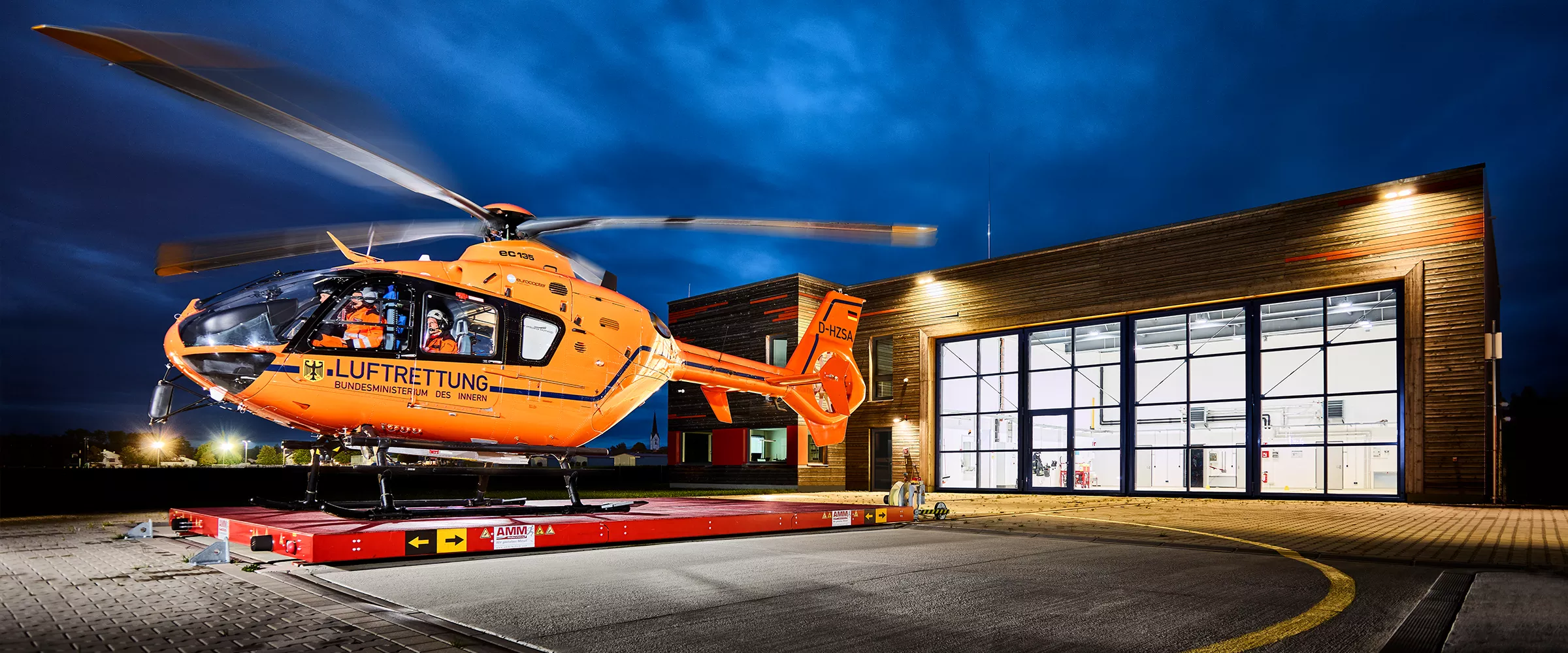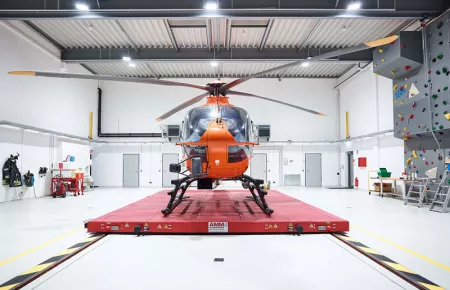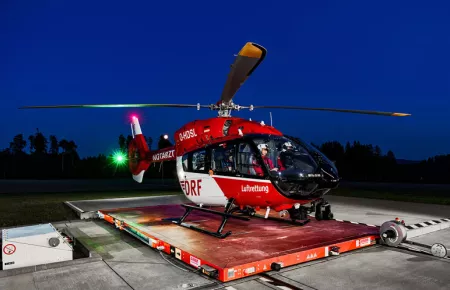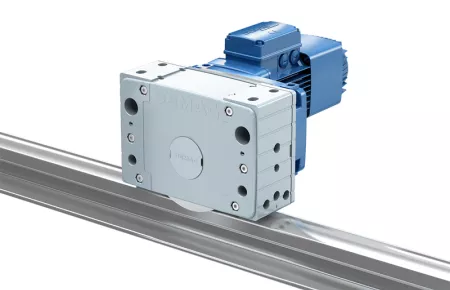
Safety before take-off and landing
Demag safety control units in helicopter landing platforms
Helicopter landing platforms supplied by AMM GmbH travel on Demag wheel blocks, which facilitate a very low design – and a high level of safety and reliability. The highly versatile Demag SCU safety control unit enables many individual safety functions to be implemented, for example laser-assisted position measurement of the platform and a check of the travel path with optional safety scanners to protect people.
Helicopters are known for their vertical take-off ability. For this reason, they can take off and land in any free space that is only a little larger than their overall length or rotor diameter. However, this ability can be a disadvantage when they need to be kept inside hangars. Unlike an aeroplane, a helicopter cannot simply roll into or out of a hangar. For this reason, the buildings are often equipped with mobile landing platforms.
AMM GmbH in Merkendorf near Ansbach, Germany, has earned a reputation in this niche market, which combines aviation with materials handling. It develops and manufactures helicopter landing platforms that are “made in Germany” and focuses on customers in the air ambulance service sector.
Central requirements: flat design, maximum reliability
AMM uses components and systems from Demag for its drives and controls. For rail-mounted platforms, AMM employs the proven DRS wheel block system. Four of the six installed wheel blocks are each driven by an offset geared brake motor. Its flat design offers particular benefits in this application. The platforms are partly lower than 250 mm. The direct drive arrangement is also important for AMM. Matthias Schloss, Managing Director: “The drive systems must be absolutely reliable. That is why we deliberately avoid any chains, shafts and other components.” For the same reason, the platforms are always equipped with various emergency-operation functions.
The wheel blocks are controlled via a Demag application module for pole-changing drives with increased safety and reliability requirements. This module is integrated into the control cabinet that travels onboard the platform. The controller with which the platform is operated is also from the Demag modular system. However, in this case AMM uses a customer-specific version with a spiral cable and enable button, alternatively also a radio control unit.
Safety systems: from one source
The AMM design engineers pay great attention to the safety concept for the landing platforms. First, they must ensure that the platform can enter and leave the hangar at slow speed and that the end position (outside) is approached slowly. Second, it must be possible to bring the platform to an immediate standstill using the emergency-off button, if necessary. And third, starting and braking must be performed with controlled and reduced acceleration and deceleration rates to protect both the helicopter and the medical equipment.
To implement these and other safety functions, AMM also works together with Demag – for good reason, since the Demag SCU safety control unit developed for these tasks is an ideal platform. From the very beginning, it was developed to meet the needs of lifting and materials handling processes, offers a wide variety of function modules and can also be easily adapted to match the requirements of complex or unconventional applications.
Extended control and safety concept
The basic functions of the Demag SCU, which AMM uses for the safe operation of its helicopter landing platforms, include a redundant emergency-stop function, position monitoring of the power contactors for both speeds and the above-mentioned start-up of the drives at reduced speed. Controlled stopping of the drives via regenerative braking is also reliably monitored.
Furthermore, however, the platforms are equipped with additional safety functions that have been fully integrated into the Demag SCU as a central safety control unit. For example, the position of the platform along its travel path is monitored by two analogue laser sensors with reflectors. These sensors – which also belong to the Demag scope of delivery – are connected to the electronic and, therefore, wear-free cams of the Demag SCU and activate the reduced speed before the safe end positions are reached. In addition, a safety light grid monitors the correct position of the helicopter when it enters the hangar. If the rotor comes too close to the hangar or its door, the platform is immediately brought to standstill.
People protected by laser scanners
A safety laser scanner from the Demag product range can be used to protect people and prevent collisions in each direction of travel. These opto-electronic safety devices are installed direct on the platform and monitor movement along the travel path at an angle of up to 240 degrees. If they detect an obstacle, they send a corresponding signal to the Demag SCU depending on the distance to the object. The control system reacts by reducing the speed or initiates an immediate safe stop of the platform.
Unlike conventional emergency-off functions, the platform is still brought to standstill with reduced deceleration for the same reasons as mentioned above. The Demag engineering teams can easily realise such special functions using the Demag SCU.
A further special function called “mirror and reflector detection” is offered by the opto-electronic safety devices on the platform. It allows personnel to walk through the area covered by the safety sensors without causing a safety stop of the platform. Therefore, the safety control unit can distinguish between humans and obstacles.
Simple configuration of special and safety functions
All safety functions meet the requirements of SIL 2 according to EN 61508 as well as Category 3 and Performance Level d according to EN 13849. Since the individual function modules can be conveniently adapted to meet specific application needs via the SafeSCU programming software, application engineers do not need to invest much time and know-how for such tasks. In most cases, they only need to program the values for the function parameters that are already included in the control system. The validation report in the configuration editor of the control system makes the deign engineer’s job even easier. It facilitates documentation to match the requirements of standards according to the Machinery Directive on the basis of an individual risk analysis.
Image gallery
Image gallery








